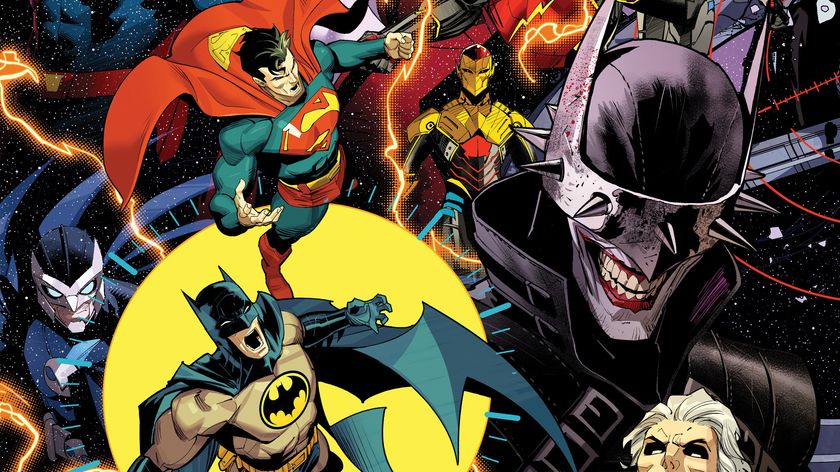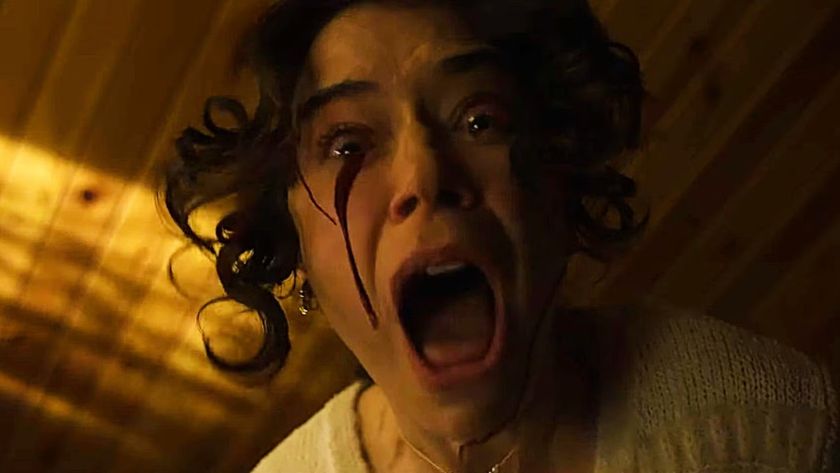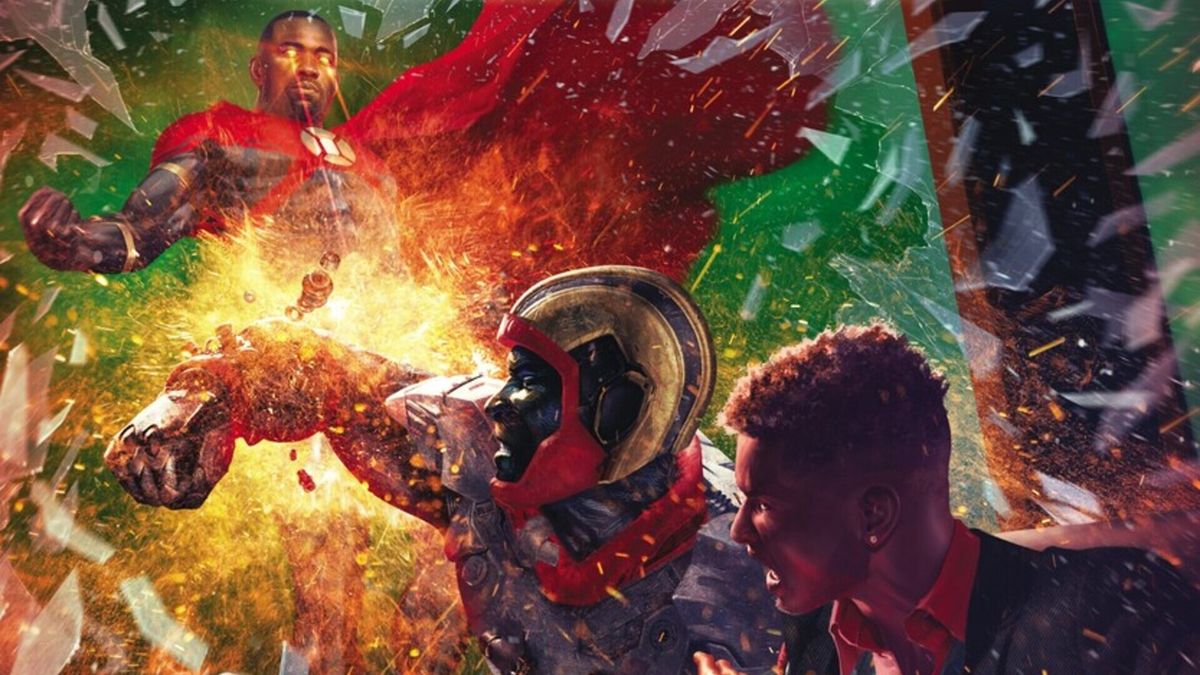
It's been nearly two years since Milestone Media marked its full return with a rebooted continuity for the Dakotaverse, the shared superhero universe populated by characters like Static and Icon.
Spoiler alert! The opening act of that relaunch culminates in the epic miniseries Icon vs. Hardware, in which the Dakotaverse's two biggest heroes throw down after Hardware attempts to re-shape the space-time continuum. While Icon moves to stop Hardware in this altered timeline, the prime Dakotaverse finds itself under attack from supervillain Vandal Savage, marking the first time this version of the Milestone characters have crossed over with the DC Universe.
Written by Reginald Hudlin and Leon Chills, and penciled by Denys Cowan and Yasmín Flores Montañez, Icon vs. Hardware hasn't pulled its punches. In an exclusive, spoiler-filled interview, Cowan and Chills walk through the shocking reveals and major moments from Icon vs. Hardware #2, and explain the big emotional beats in the series so far...
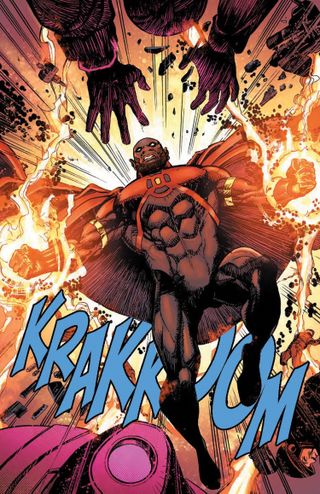
Newsarama: A title like Icon vs. Hardware evokes a straight up superhero fight, but this series has timelines colliding and the entire fabric of space and time in the Dakotaverse being changed. How has it been jumping into this epic confrontation?
Denys Cowan: It's very exciting! It's scary, in a way, because Brandon Thomas wrote Hardware in a certain way that was probably close to what Dwayne [McDuffie] was doing. Reggie, when he writes Hardware, has his own concept of who he is and what he can do. Sometimes it surprises me and I'm like, "I didn’t know Hardware could do that!" Other times, I'm like, "That's so cool! That really works!"
Taking Hardware and Curtis Metcalf into this conflict and the way Reggie is writing him has been extremely informative because he’s taking this aspect of Curtis that's, "I don't give an eff what happens as long as I fix this thing, make it right, or bend it to my will." That's a big part of who Curtis is and a big part of what's driving this storyline. Reggie and Leon are exploring that to the fullest and it's been a wild ride, even for me - and I'm drawing the thing!
Vandal Savage appearing at the end of the second issue is a huge twist. How is it incorporating him and elements of the DCU into the new Milestone Universe?
Comic deals, prizes and latest news
Get the best comic news, insights, opinions, analysis and more!
Cowan: It's fun! I'm a Vandal Savage fan. Smarts and brute force are a lethal combination and it's been fun drawing him in all the various scenarios. This may be the start of bigger things and I'm very aware of that when I'm drawing this stuff. I'm trying to pace it in what we're showing and doing, especially when it comes to Vandal Savage.
Leon Chills: When I was brainstorming with Reggie, I told him that we needed someone who could exist through the course of history and he immediately suggested Vandal Savage. That made perfect sense because the idea, at the end, is that you see the same person in different timelines fighting our heroes in both instances. To have him be involved in something as impactful as the slave trade was crazy, but it was like, "What would a supervillain have done back then that changed the course of history?"
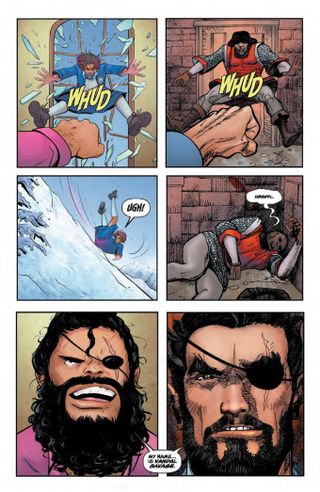
I've spoken with Reggie before and while he’s said all the Milestone characters are like your kids, you have a special appreciation for Curtis Metcalf, right?
Cowan: I think Static was the first one that we all created when Dwayne, Michael [Davis], Derek [T. Dingle] and Christopher Priest all got together and created the characters. Hardware was the one that was the closest to my heart because it was Dwayne and my character. We had done Deathlok over at Marvel and we loved working together. We tried to bring that kind of sensibility into Milestone, we just wanted to create our own guy and we did.
Curtis Metcalf is probably that part of myself and Dwayne that couldn't give an eff. I’m not a genius, but Dwayne was, so that’s probably where you get Curtis's genius. I certainly feel morally outraged at things that go on in this world and I want to do something about them. One of the things we did was create a whole comic book company to address the inequalities in comics and in literature. Hardware was the manifestation of how we felt at the time. As I've gotten older, that fire has changed, but it's just as intense. There's so much of Dwayne and myself in that character, including working for a major corporation then getting kind of ripped off.
You run the gamut with this issue, with war sequences, superhero battles, different time periods, and a legal drama...
Cowan: It was a hell of an issue to draw because it really took me everywhere. There were scenes of superheroes fighting, there were scenes of crowds being gassed. There's a lot of stuff going on in that issue. I remember reading the script and then it slowly began occurring to me that it had a cast of thousands and I had to draw all of these people!
I think I've done some of my best stuff on it, John Floyd is certainly a terrific inker and Chris Sotomayor is a wonderful colorist. With the script and everything else, I think we turned out a hell of an issue for #2.
Chills: We're extremely excited with everything that's happening in this issue and, particularly, the rest of the run. When we did interviews for #1, we were like, "Trust us, it’s coming!" It’s pretty much like that for the rest of the run because, once you introduce the time-travel element, it feels like anything is possible. We already think big - with Icon and Rocket season 1, we stopped the global drug trade. We're going to go off the planet and further back in time. We're excited to do it all.
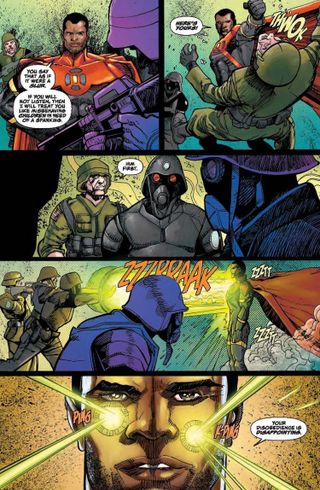
The first two issues have largely centered on Hardware, but Icon steps up in a big way in this issue and we see why he wants to confront Curtis as reality shifts around him...
Cowan: Icon really is, in a way, the moral center of the Milestone Universe. Whenever he shows up, it's serious stuff but, usually whenever he shows up, he's balanced out by Rocket. Having him without her, you get a different Icon. He is raw and about his business stopping Curtis no matter what. You don't change timelines and Icon is the one to stop all that.
Chills: Not only does Icon not have [Rocket], but she was killed throughout the course of this war. That's why you see him go straight for Curtis. The hope that he had is gone with her and he gives that last plea but, from then on, he's just going to fight the only way that's left to fight. That's why he goes so hard against the soldiers and the two Hardwares.
It's also why we were like, "There is no way he's going to lose this fight!" In addition to him being super-powered and them having the technological advancements, the mindset of a brutal Icon is tough to beat.
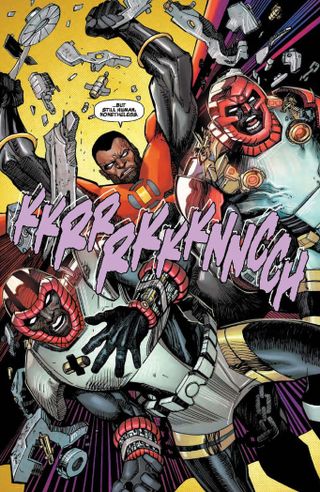
It’s been over a year since you relaunched Milestone. How did you want to take advantage of this rebooted continuity with this event?
Cowan: Basically, we're concerned with just telling good stories and great stories. One of the best stories that we ever did was the Worlds Collide thing that we did back in 1994. The thought of our characters against each other and then interacting with the DC Universe 30 years later was something that we could not pass up on, it was just too exciting. The minute we started pitching it and kicking it around, the better the idea got.
You can expect to see some very unusual team-ups coming up. What we have planned is mind-blowing. Hopefully, people really dig that second issue because it's really the setup of everything that comes after.
Chills: I think all of the season 1 runs went very well and season 2 of Static is really good too. They certainly laid the foundation for us to go any place that we want to. The goal is always to try to go bigger than the original run, since that exists as it is. We typically don't want to retread anything that they did before, it's part of the reason why you don't see Rocket with a child - they've done that before. We're finding something different in her personal life to present challenges. She definitely didn’t go to a boarding school in Switzerland in that original run!
We definitely have much more of a global mindset in our storytelling because it's a big world out there and we're putting them in different places. I think what you're seeing now is the start of a much larger crossover with Vandal. Now it's about these Milestone characters to DC-proper characters.

Rocket is without Icon in the prime timeline, especially as she faces off against Vandal Savage alone. How is it placing Rocket in this situation, with one of DC’s greatest supervillains gunning for her?
Cowan: The Rocket sequences in the book are drawn by Yasmín Flores Montañez. She's awesome and she has a whole different take on storytelling than I do. I do enjoy seeing what she does as she's handling all the Rocket sequences.
Without Icon to balance her, we get to see a lot of who she really is, what her personality is, and why she is the way that she is. It's good to watch her independent of Icon and see how she handles it. She is up against Vandal Savage, one of the most powerful villains, so you've got to tune in to see what happens. It doesn't start off so well for her, I'll say that.
Chills: I felt like there was a cool way we did the deja-vu. In our universe, deja-vu means someone has fixed time so that things occur as they should. [Rocket] already feels like she's on an island but she has found a friend, at least. The whole setting has been very unsettling for her and that's only going to increase with the presence of Vandal. Icon still exists so she'll definitely have an opportunity to reach out, should she need to, in that fight with Vandal.
Even as Hardware is changing history, reality is pushing back, with things like the Big Bang coming off as inevitable despite his best efforts...
Cowan: We're not going to change the continuity of what we've done just because Curtis wants to travel through time and change it for us! But it speaks to his personality, that he would not care what the consequences were if he could get what he wanted to get. It also speaks to reality in that things don't always work, there has to be some kind of opposing force. You're not going to change time and everything forever just because you want to.
There's a moral lesson here that Curtis is going to learn. He's also going to come out of it a better person. Everything is going to be intact, with a few small changes.
Chills: That's kind of the story with Curtis. He ran into Edwin Alva and the harsh reality of being extremely smart and capable only to be betrayed by someone that he trusted. It's kind of why he's in the place of wanting to take control, more so than if things had gone the way they should have with Edwin.
Coming off that betrayal, he sees this as an opportunity to take control of things. He's running into the same type of things that occur in his everyday life, he can't escape it. That's one of the lessons of the story, even if you change things, what's meant to be is still going to happen, just in a different way.
Leon, what were some of the challenges in developing the mechanics of time-travel for this particular story?
Chills: We definitely ran into some hiccups with that. One thing we came up with was that whole deja-vu thing as a rule and it wasn't one I had seen used with time-travel before. We decided to use it as a way to put a band-aid on that in a way that made sense to us. At the same time, time-travel isn't real, so we can say what we want to up to a certain point and that's what we chose to do! The deja-vu thing solved a lot of things for Rocket because we didn't want to have her completely removed from the story in that primary universe.
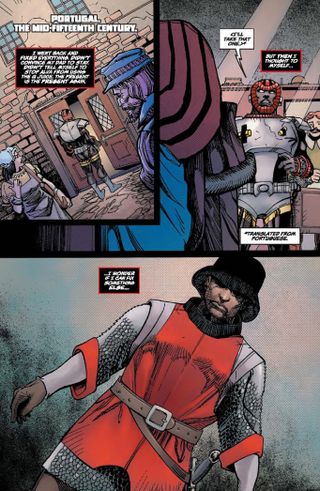
The emotional knockout scene of the series so far has Hardware go back in time to see his father before he abandoned the family when he was a kid. How was it digging into the emotions for that?
Cowan: It was a great scene to draw. It was a little difficult emotionally but it was good. Black fathers are not as absent as people like to say that we are, we're not. There are all kinds of reasons why things happen, there are very adult reasons why things happen. That's what Curtis is finding out in that scene, that it wasn't just that [his father] picked up and left, it was a lot more than that.
That script was one of the best scripts I had ever read or drawn, it was great. Taking it there and showing that he wanted to change the past, even at that point, was incredible. It was great drawing that scene and I hope people got something out of it because I certainly did.
Chills: I think that, emotionally, it made [Curtis] feel like bigger changes could be possible. Curtis didn't have the hole in his heart that allowed Edwin to have such a strong hold on him, so maybe, if that worked, other things could too. Closing that wound for him emotionally has freed him to do whatever he wants, without that past trauma.
Decades on, how is your creative shorthand with Reggie, especially when you're working on something as ambitious as this?
Cowan: Same as it's ever been. We get together and discuss things, he goes off and writes stuff, I get it and go, "This is impossible to draw, there are way too many people, and way too much stuff going on!" But then I draw it anyway and it’s always great. All kidding aside, him and Leon are awesome writers.
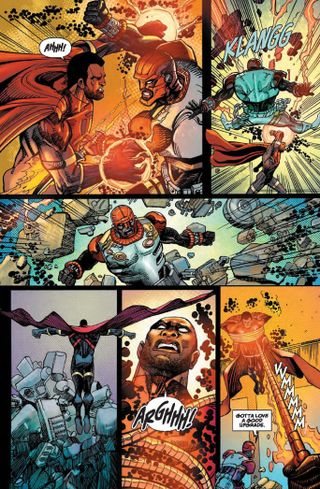
Leon, how is it writing with Reggie for Denys and Yasmín with the wide range of this story?
Chills: We just try to raise the bar and almost make it difficult for them! We try to present them with a challenge of how they're going to do this and they always come back rising to that challenge. I think that's how we make it better each time, to challenge them in ways that they maybe haven't been before.
A storyline of this magnitude is certain to impact other titles like Static and Blood Syndicate.
Cowan: By the time this is over, while the Dakota Universe will be intact, it will be changed forever. It's a big deal storyline and, what I really liked, is people’s response to Icon vs. Hardware. People have really been digging that book, picking it up, and getting into it for all the reasons that I hoped they would. Reggie and I have been very grateful and pleased with the success of those issues, it's been good.
What else can you tease about #3?
Cowan: It picks up right where #2 left off, literally within the next second. It starts off with a lot of action and then just goes on. I'm drawing half that book and Darryl Banks is drawing the other half. He's an awesome artist and I'm working on that book right now and having a great time.
Chills: As far as Rocket's timeline, Vandal is a lot to handle, so that call to Icon is always a possibility. He can get to Switzerland in a flash, even though he's in Dakota. I would tease that it doesn't end with Vandal, in terms of surprising introductions, I'll say that. He is the teaser to what is possible now, he's not the end-all, be-all.
Icon vs. Hardware #2 is written by Reginald Hudlin and Leon Chills, penciled by Denys Cowan and Yasmín Flores Montañez, inked by John Floyd and Montañez, colored by Christopher Sotomayor, and lettered by AndWorld Design.
The story continues in Icon vs. Hardware #3, on sale May 9 by Milestone Media and DC Comics.
Vandal Savage started out as one of Alan Scott's enemies. Here are some of the best Green Lantern stories of all time.
Sam is a freelance writer contributing to 12DOVE. Sam has been working in entertainment journalism since 2016 for outlets including CBR, Popverse, /Film, and more, conducting interviews and writing reviews and columns covering comic books, television, film, and video games. With an expertise spanning the breadth of pop culture, Sam is especially knowledgeable on Star Trek, Nintendo, and DC Comics. In his free time, Sam likes to play guitar poorly and travel around the world.
Most Popular






